How do you really feel on the subject of Finding the Right Plumbing Expert?

Acrylic bathrooms, shower trays, as well as other acrylic restroom ware have ended up being much more common in bathrooms in current times. Not as sophisticated and also sturdy as enamel and also porcelain baths as well as fixtures, they are extra cost effective as well as offer quite a lot the very same basic objective. Some usual examples of damage to acrylic washroom fixtures consist of staining, splits, holes, etc.
Damaged shower or bathroom surface area
Polymer washroom components are not abrasion-resistant like enamel varieties. Being an extremely soft material, acrylic scratches can even be hidden without finish or filling. For these, you should look for professional assistance for your bathroom repairs.
Chemical Reactions
Sometimes, people try to repaint the entire surface area of their acrylic bath on their own either since they do not like the shade to conceal imperfections. When they do not like the end result, they apply paint removers. You must never ever utilize paint remover on acrylic baths. Although paint eliminators do not respond with the surface of steel bathrooms, they destroy acrylic bathrooms irreversibly. This creates much more benefit the specialist. The most effective strategy right here is to call an expert for help with replacing the bathroom.
Bathroom Discoloration
With long term use of acrylic baths comes discoloration or staining. While some discolorations can be gotten rid of quickly, utilizing unique chemicals, others need that the bath be resprayed. Aromatherapy oils loosen up the dirt in some instances therefore recovering the bath to its previous glory.
Split Polymer Baths
The life-span of acrylic and also fiberglass bathrooms is up to 15-20 years for shower pans as well as bathrooms, usually. Fractures in an acrylic shower tray are possibly among the simplest troubles to repair for a repair service expert. This is the very same for PVC, resin, and various other such materials.
Polymer baths, shower trays, as well as other acrylic shower room ware have become more common in restrooms in current times. You ought to never use paint remover on acrylic baths. Paint eliminators do not respond with the surface area of steel baths, they damage acrylic bathrooms irreversibly. With prolonged use of acrylic baths comes staining or discoloration. The life expectancy of acrylic and fiberglass baths is up to 15-20 years for shower pans and baths, usually.
How to clean Acrylic shower
USE THESE NON-ABRASIVE CLEANERS
We recommend that you clean your acrylic bathing product made of Delta ProCrylic or Acrylic with Innovex Technology with non-abrasive soaps and cleaners, such as:
Dishwashing detergent Power Bathroom Cleaner CLR® Bath & Kitchen® Cleaner Formula 409® All-Purpose Cleaner Iron Out® Rust Stain Remover When it’s time to clean, always use a terry cloth towel, soft cloth or sponge to avoid scratching the acrylic surface. Don’t use abrasive scrubbing pads, steel wool or sponges, cause permanent damage to the acrylic material. If you use a drain cleaner or clog remover, be sure to rinse thoroughly with water so no product is left standing near the drain.
Some chemicals and cleaners may deteriorate acrylic surfaces, causing cracks and, potentially, property damage. To avoid this, don’t use cleaning products that state on their label that they are not suitable for use on Acrylic, ABS, Polystyrene or Plastic. Be sure to check the label of any product before you apply it to the surface; it’s easier to avoid damage than to try to remedy it.
DO NOT USE THESE CLEANERS
Chemicals we do not recommend using to clean acrylic showers/tubs:
Solvents (turpentine, lacquer thinner, mineral spirits, paint thinner, MEK, xylene, acetone, naphtha, etc.) Simple Green® All-Purpose Cleaner Pine-Sol® Original Scrubbing Bubbles® Cleaner Tilex® Bathroom Cleaner The Works® Tub & Shower Cleaner Lysol® with Hydrogen Peroxide Multi-Purpose Cleaner Windex® Vinegar Multi-Surface Cleaner Sealant Application Tips
When you’re ready to apply sealant, a little planning goes a long way. Pick up some painter’s tape and use it to mask off the seam to help make cleaning up easier. When you’re applying the bead, use a constant, steady speed to avoid an uneven finish. Use a caulk tool or a plastic spoon to work the sealant into the joint. Wetting the tool with denatured alcohol will help create a smooth finish. Follow the directions on the back of the tube for cure time.
Certain chemicals and cleaners may deteriorate acrylic surfaces, causing cracks and, potentially, property damage. After you’re finished applying it, clean up the product surface and remove any excess sealant with denatured alcohol. Don’t use solvents (turpentine, lacquer thinner, mineral spirits, paint thinner, MEK, xylene, acetone, naphtha, etc.) that can wreak havoc on an acrylic surface.
With a little care and consideration, you can prevent damage to your acrylic shower or tub. Keep a supply of soft cloths handy and remove any damaging products or abrasive scrubbing items from the bathroom to ensure they aren’t around when it’s time to clean.
https://www.deltafaucet.com/design-innovation/inspiredliving/how-to-clean-acrylic-shower

Do you really like reading about Hiring a Plumbing Expert? Put feedback down the page. We will be delighted to hear your reactions about this entry. Hoping to see you back again in the near future. Sharing is good. Helping others is fun. We appreciate reading our article about Hiring a Plumbing Company.
Request An Estimate